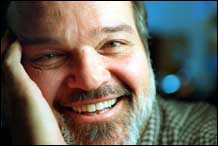The main reason
I decided to go to the Ventura Platypus Workshop- after years of waffling-
was a film I saw last year on the Sundance Channel. Peter Wintonick's
"Cinema Verite: Defining the Moment" traces the evolution
of the verite' movement through interviews with the filmmakers, many
of whom translated the meaning of Cartier-Bresson's "Decisive Moment"
into 16mm/sound storytelling. Real Work Our photojournalism
can be as one-dimensional as we want it to be. We can shoot an assignment
for our paper or magazine or shoot a piece for "Nightline"
and be done with it, or we can look at every job we pitch (or decide
to take) as another paragraph in a book that may take us 10 or 20 years
(or a lifetime) to write. Here is a partial list of sites I think will be of interest to still photographers who want to find out more about Cinema Verite' and Documentary Film. Networks/Distributors: http://www.pbs.org/wgbh/pages/frontline/ http://www.pbs.org/frontlineworld/ http://www.pbs.org/pov/ http://www.hbo.com/docs/ http://www.nfb.ca http://www.buyindies.com http://www.firstrunfeatures.com/ http://www.studiodepot.com/asc/ Filmmakers: Frederick Wiseman: "Titticutt Follies", "High School", "Zoo", others http://www.zipporah.com/ Albert and David Maysles: "Salesman", "Grey Gardens", "Gimme Shelter" http://www.mayslesfilms.com Errol Morris: "Gates of Heaven", "Vernon, Florida", "A Brief History of Time" "Thin Blue Line", "Fast, Cheap and Out of Control", "Mr. Death" http://www.errolmorris.com http://www.jl-site.com/Directors/ErrolMorris.html William Klein: "Broadway by Light", "Muhammad Ali: The Greatest", "Eldridge Cleaver, Black Panther". http://www.sidf.co.uk/festival00/articles/william_klein.htm Ann and Jeanette Petrie: "Mother Teresa" http://www.petrieproductions.com/pp/ Peter Wintonick: "Poetry in Motion", "Manufacturing Consent" http://www.nfb.ca/cinemaverite/english/2/2ca.html Ross McElwee: "Sherman's March", "Charlene", "Backyards" "Six O'Clock News" http://www.pbs.org/wgbh/pages/frontline/shows/news/etc/bio.html Mickey Lemle: "Ram Dass: Fierce Grace", "Compassion in Exile: The 14th Dalai Lama" http://www.zeitgeistfilms.com/current/ramdass/ramdasslemle.html Danny Lyon: "Born to Film", "Willie" http://www.sfff2000.com/lyon.html http://faculty.washington.edu/rods/art_lyon.html Bruce Weber: "Broken Noses", "Chop Suey" http://www.zeitgeistfilms.com http:/www.bruceweber.com Mary Ellen Mark: "Streetwise" http://www.salon.com/people/bc/2000/03/28/mark/index.html Bruce Davidson:"Isaac Bashevis Singer's Nightmare and Mrs. Pupko's Beard" http://www.magnumphotos.com "Stranger with a Camera" (NFB filmmaker murdered while shooting documentary) http://www.itvs.org/strangerwithacamera/ Ruth Orkin/Morris Engel: "The Little Fugitive" (feature) http://www.brightlightsfilm.com/26/engel.html John Grierson "Night Mail" (coined the term "documentary film") http://www.britmovie.co.uk/biog/g/003.html Robert Flaherty: "Nanook of the North", "Moana", "Man of Aran" http://nimbus.temple.edu/~jruby/wava/Flaherty/ Paul Strand: "Native Land", "Mannahatta", "The Plow the Broke the Plains" http://photography.about.com/library/weekly/aa081699c.htm Pare Lorentz: "The Plow the Broke the Plains", "The River" http://xroads.virginia.edu/g/1930s/FILM/lorentz/front.html Henri Cartier-Bresson: "Le Retour" (1944) "Impressions of California" (CBS, 1969), "Southern Exposure" (CBS, 1969) (Still looking for the best HC-B film site) Robert Frank: "Pull My Daisy", "Me and My Brother", "Conversations in Vermont" (Still looking for the best Frank site) Eli Reed: "Poorest in the Land of Plenty" (Dir. Scott Fraser,1989, NBC/National Council of Churches) About Filmmakers/Photographers "?: Henri Cartier-Bresson", Sarah Moon, 1994 "Fire in the East" (about Robert Frank) MoFA Houston, 1986 "Photography Made Difficult" (Docudrama about W. Eugene Smith) American Masters, 1989 "A Brief History of Erroll Morris", IFC, 1999. "Light Keeps Me Company" (Sven Nyquist) 2000 I'd appreciate your help in expanding this list to include a more diverse and international selection of films and filmmakers. Send links to me at kkomenich@sfchronicle.com--kk Kim Komenich has worked as a staff photographer for the San Francisco Examiner from 1982-1998. From Sept., 1998 to June, 2000 he served as a visiting instructor in the photojournalism department of the Missouri School of Journalism while working on his graduate degree. He returned to the Hearst-owned San Francisco Chronicle in the June, 2000 after the merger with the Examiner. He was a teaching fellow at the U.C. Berkeley graduate School of journalism in Fall, 2001. He is currently the Chronicle’s photo coach. He received the 1987 Pulitzer Prize for his coverage of the Philippine revolution. He has also received the World Press Photo award for picture stories and the Distinguished Service Award from the Society of Professional Journalists. His photography has appeared in LIFE, Time, People, Fortune, Newsweek, U.S. News and World Report and news magazines around the world. He was among photographers invited to photograph the "A Day in the Life of California", "Christmas in America", "Power to Heal", "One Earth", and "The Mission" books. His work is included in "15 Seconds: The 1989 San Francisco Earthquake". He has covered stories in Vietnam, the former Soviet Union, El Salvador, and Guyana. He has worked extensively in the Philippines. |
|
|
Write a Letter
to the Editor |
